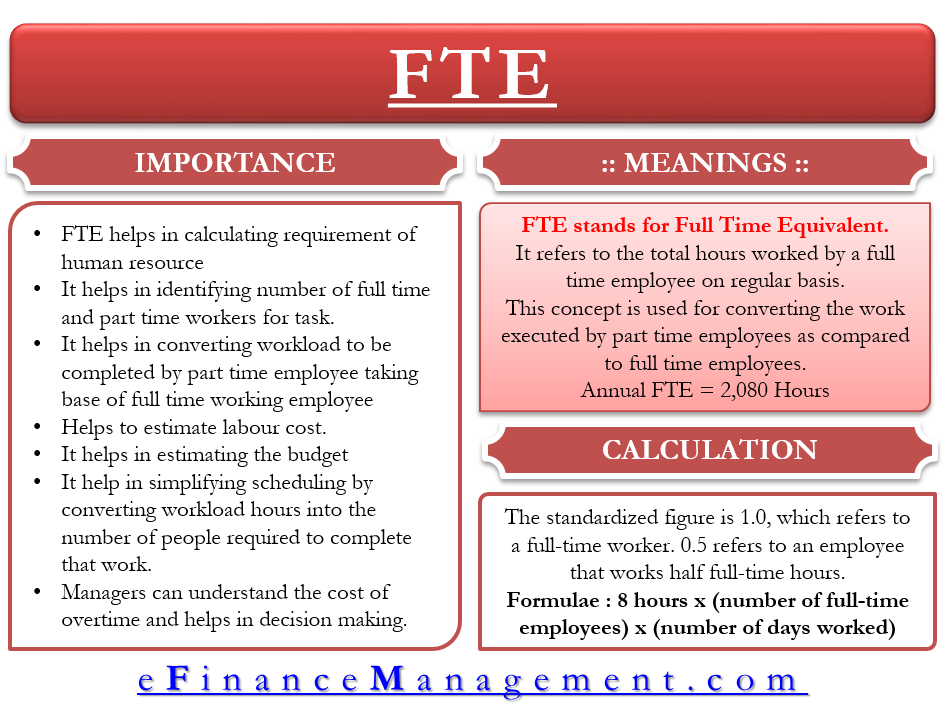FTE: Meaning
FTE is Full-Time Equivalent; it represents the total hours worked by a full-time employee on a regular basis. The organization uses the concept of converting the work executed by part-time employees compared to full-time employees. It is a term representing a unit that explains the degree of involvement or work undertaken by an employee. It is equal to the total work executed by one full-time worker.
The annual FTE is 2,080 hours, which the company calculates as 8 hours per day and 5 days a week.
FTE= 8 hours * 5 days* 52 weeks = 2080 hours
The standardized figure is 1.0, which refers to a full-time worker. 0.5 refers to an employee that works half full-time hours.
Example
1 FTE means 100% capacity, i.e., usually 8 hours a day (full-time)
0.5 FTE means 50% capacity, i.e., usually 4 hours a day (half-time)
It is used to determine the requirement of human labor for a project or a task. It measures the labor capacity a project, activity, or task needs. The main purpose of using FTE is to calculate the cost — in time, money, and personnel — of the project. The business uses this concept in project management and resource management for staffing decisions.
FTE concept helps determine the workload and accordingly determines the number of part-time employees and the number of hours they will work. This is crucial for accounting purposes and wages determination, and total expenses incurred for paying the workers.
It helps in standardizing the salaries by showing what the equivalent salary would be of a part-time employee taking the base of working full-time. A pro-rata salary is calculated for part-time employees by adjusting their working hours with the help of FTE.

FTE Calculation
FTE= 8 hours x (number of full-time employees) x (number of days worked).
For an instant, a project estimates to require 500 hours, with the help of FTE, you can calculate the following equation.
FTE equation: 8 hours x (number of full-time employees) x (number of days worked) = 500 hours.
Thus, the number of full-time employees working full eight hours is 62.5.
The company can make a different combination to satisfy this 62.5, like six full-time employees and one part-time employee to work on the project for 10 days. Or even appoint 12 full-time and one part-time resource for five days to complete the work. The company can modify and diversify the calculation by considering the project’s scope and requirements. Thus, the FTE calculation helps in managing human resources efficiently.
Importance of FTE
- FTE helps in calculating the requirement of human resources for a particular project or task
- Helps in identifying the number of full time and part-time workers for a task
- It assists in converting the workload to be completed by a part-time employee taking the base of a full-time working employee.
- Acts as a unit for calculating the workload and accordingly arranges the human resource.
- With the help of FTE, project managers estimate the cost of labor
- It contributes to estimating the budget and preparing it accordingly and thus makes the task of budget analysts easy.
- FTE help in simplifying scheduling by converting workload hours into the number of people required to complete that work.
- Managers can understand the cost of overtime by looking at FTE and can make a decision whether overtime is cost-effective or opening up a new full-time or part-time position.
Conclusion
Thus FTE, termed Full-Time Equivalent is a unit that represents the total hours worked by a full-time employee on a regular basis. The costing team uses the concept of converting the work executed by part-time employees as compared to full-time employees. It helps determine the number of full-time and part-time employees for a task or project.
It helps in the cost determination of a project considering the personnel management.
The main aim of using FTE is to calculate the cost related to the time, money, and personnel of the project or activity. It contributes to project management and resource management for staffing decisions. Thus it is a very important costing term used by organizations to determine the number of full-time and part-time employees for a task and the cost associated with it.

